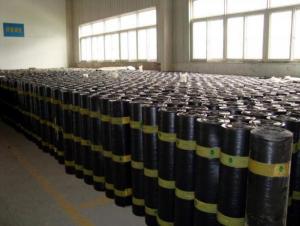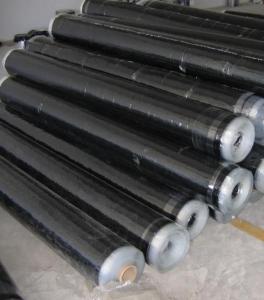EPDM Waterproofing Membrane For Construction Field
- Loading Port:
- Qingdao, China
- Payment Terms:
- TT or LC
- Min Order Qty:
- 2000 M2 m²
- Supply Capability:
- Above 10000000M2 Per Year m²/month
OKorder Service Pledge
OKorder Financial Service
You Might Also Like
Detailed Specification for EPDM Waterproofing Membrane:
|
Type |
EPDM Waterproof Membrane | |||
|
Material |
EPDM Rubber | |||
|
Thickness |
1.0mm |
1.2mm |
1.5mm |
2.0mm |
|
Size |
1.2m(width) * 20m(length)/roll, Weldale could 4m width | |||
|
Type |
Vulcanized & Weldable | |||
|
Pattern |
Non-reinforced(homogeneous) | |||
|
Packing |
24sqm--80sqm/roll, with plastic bag | |||
|
Color |
Black | |||
|
Application |
Roof, basement, pond, Lake, steel structure roof, swimming pool, underground, tunnel, etc | |||
Product Features of EPDM Waterproofing Membrane:
1. the excellent anti-aging, in the long term light, humidity, cold use of the natural
environment, small changes in physical properties, used in the temperature:
From -50 degree Celsius to +80degree Celsious.
2.with outstanding ozone resistance, resistance to ultraviolet and atmospheric corrosion
of many chemical corrosive substances.
3. high tensile strength, high elongation, high flexibility, capable of sustaining
a puncture of hard material, good anti-crack, high adaptability of the grass roots'
contraction and the crack and deformation, and give full play to extend the
performance, playing the role of waterproofing.
4.long lifetime, high durability can achieve more than 25 years.
5.the cold construction operation, no environment pollution and simple operation.
Application Pictures of EPDM Waterproofing Membrane:


- Q:Can waterproofing membranes be used on elevator shafts?
- Yes, waterproofing membranes can be used on elevator shafts. Elevator shafts are often subject to moisture, especially in areas with high humidity or underground installations. Waterproofing membranes are designed to provide a protective barrier against water and moisture, preventing them from seeping into the elevator shaft and causing damage to the structural components or electrical systems. These membranes are typically applied to the walls and floors of the shaft, creating a watertight seal that keeps the interior dry. Additionally, waterproofing membranes can also help to prevent the growth of mold and mildew, ensuring a safe and healthy environment for elevator passengers and maintenance personnel.
- Q:Is a waterproofing membrane resistant to solvents or chemical spills?
- Yes, a waterproofing membrane is typically resistant to solvents or chemical spills. Waterproofing membranes are designed to provide a protective barrier against water and other liquids, including solvents and chemicals. These membranes are often made of materials such as PVC, TPO, or EPDM, which have excellent resistance to various solvents and chemicals. However, the specific resistance may vary depending on the type and composition of the membrane. It is always recommended to check the manufacturer's specifications and consult with professionals to ensure the membrane's compatibility with specific solvents or chemicals before installation.
- Q:Can a waterproofing membrane be used in elevator pits or sump pits?
- Yes, a waterproofing membrane can be used in elevator pits or sump pits to prevent water infiltration and protect the structure from potential damage caused by moisture.
- Q:Can a waterproofing membrane be used for parking garage ramps and driveways?
- Yes, a waterproofing membrane can be used for parking garage ramps and driveways. It serves as a protective barrier against water infiltration, preventing damage to the underlying structure and extending its lifespan.
- Q:Can a waterproofing membrane be used on precast aluminum surfaces?
- Indeed, precast aluminum surfaces can be effectively protected by utilizing a waterproofing membrane. These membranes are specifically engineered to safeguard various surfaces, encompassing concrete, metal, and other materials, against water infiltration. By acting as a formidable barrier, the membrane effectively thwarts the ingress of water into the precast aluminum surface. This proves to be especially advantageous in locales with elevated moisture exposure, such as surrounding swimming pools or outdoor environments. It is crucial to select a waterproofing membrane that is aluminum-compatible in order to guarantee optimal adhesion and long-lasting efficacy.
- Q:Are waterproofing membranes resistant to acid rain?
- Yes, waterproofing membranes are generally resistant to acid rain. Waterproofing membranes are designed to provide a barrier against water penetration, and they are typically made from materials that are resistant to various environmental factors, including acid rain. Acid rain is caused by the emission of sulfur dioxide and nitrogen oxide pollutants, which react with water vapor in the atmosphere to form sulfuric and nitric acids. These acids can corrode and damage certain materials over time, but waterproofing membranes are specifically engineered to withstand acid rain and other environmental stresses. They are commonly made from materials such as modified bitumen, thermoplastic polyolefin (TPO), ethylene propylene diene monomer (EPDM), or polyvinyl chloride (PVC), which have high resistance to acid rain. Additionally, some waterproofing membranes may have additional protective coatings or additives that enhance their resistance to acid rain, ensuring long-term durability and performance. However, it is important to note that the exact resistance level of a waterproofing membrane to acid rain may vary depending on the specific product and manufacturer, so it is always recommended to consult the manufacturer's guidelines or specifications for accurate information.
- Q:Are there any specific fire safety considerations for using a waterproofing membrane?
- Using a waterproofing membrane requires specific fire safety considerations. Although these membranes are designed to protect structures from water and moisture-related issues, they can also pose fire safety challenges. To begin with, it is important to evaluate the fire resistance rating of the waterproofing membrane. Building codes and regulations often mandate specific fire resistance ratings for different components of a building, such as roofing and wall systems. Therefore, it is necessary to assess the fire resistance rating of the waterproofing membrane to ensure compliance with these requirements. Moreover, the installation process of a waterproofing membrane involves the use of flammable materials like adhesives and sealants. It is crucial to choose fire-resistant materials and employ proper installation techniques to minimize the risk of fire hazards. Furthermore, the presence of a waterproofing membrane can impact the spread of fire and movement of smoke within a structure. It is essential to consider how this affects fire compartmentalization, evacuation routes, and the overall fire safety strategy of the building. Additional fire protection measures, such as fire barriers, smoke management systems, or fire-rated enclosures, may be necessary to compensate for the presence of the waterproofing membrane. Regular inspections and maintenance of the waterproofing membrane are also vital. Over time, the membrane can degrade, crack, or sustain damage, compromising its fire-resistant properties. Therefore, routine inspections and timely repairs or replacements are necessary to maintain the desired level of fire safety. In conclusion, ensuring fire safety when using a waterproofing membrane involves evaluating the fire resistance rating, using fire-resistant materials during installation, assessing the impact on fire spread and smoke movement, and implementing proper maintenance practices. These considerations are crucial for maintaining overall fire safety when utilizing a waterproofing membrane in a building.
- Q:Can a waterproofing membrane be used for a residential building facade?
- Yes, a waterproofing membrane can be used for a residential building facade. It can provide protection against water infiltration, preventing moisture damage to the structure and enhancing its durability. Additionally, using a waterproofing membrane can help maintain the aesthetic appearance of the facade by preventing staining or discoloration caused by water penetration.
- Q:Can a waterproofing membrane be used in crawl spaces?
- Yes, a waterproofing membrane can be used in crawl spaces. Crawl spaces are vulnerable to moisture and water intrusion, which can lead to issues such as mold, mildew, and structural damage. Using a waterproofing membrane can help protect the crawl space from water damage by creating a barrier against moisture. The membrane is typically installed on the walls and floor of the crawl space, effectively sealing it off from water and preventing water from seeping in. This can be especially beneficial in areas with high water table levels or frequent flooding. Additionally, the waterproofing membrane can also help to improve indoor air quality by preventing the growth of mold and reducing the presence of allergens. It is important to consult with a professional to determine the most suitable waterproofing membrane and installation method for a specific crawl space, as different crawl spaces may have varying requirements.
- Q:Can a waterproofing membrane be used for basements and crawl spaces?
- Basements and crawl spaces can benefit greatly from the use of a waterproofing membrane. To safeguard against water damage and moisture-related problems, it is highly advisable to employ a waterproofing membrane in these areas. The waterproofing membrane functions as a slim layer of material that is applied to the walls and floors of basements and crawl spaces, establishing a barrier against water and moisture infiltration. This technique effectively keeps the area dry and averts water seepage, which can lead to structural deterioration, mold growth, and various other complications. Waterproofing membranes are built to be resilient and enduring, offering a dependable solution for safeguarding basements and crawl spaces against water intrusion.
1. Manufacturer Overview |
|
|---|---|
| Location | Beijing, China |
| Year Established | 1998 |
| Annual Output Value | Above US$ 30 Million |
| Main Markets | Mid East; Eastern Europe; North America; Southeast Asia |
| Company Certifications | ISO 9001 |
2. Manufacturer Certificates |
|
|---|---|
| a) Certification Name | |
| Range | |
| Reference | |
| Validity Period | |
3. Manufacturer Capability |
|
|---|---|
| a)Trade Capacity | |
| Nearest Port | Tianjin |
| Export Percentage | 41% - 50% |
| No.of Employees in Trade Department | Above 50 People |
| Language Spoken: | English; Chinese |
| b)Factory Information | |
| Factory Size: | Above 600,000 square meters |
| No. of Production Lines | Above 10 |
| Contract Manufacturing | OEM Service Offered; Design Service Offered |
| Product Price Range | Negotiated |
Send your message to us
EPDM Waterproofing Membrane For Construction Field
- Loading Port:
- Qingdao, China
- Payment Terms:
- TT or LC
- Min Order Qty:
- 2000 M2 m²
- Supply Capability:
- Above 10000000M2 Per Year m²/month
OKorder Service Pledge
OKorder Financial Service
Similar products
New products
Hot products
Related keywords



























